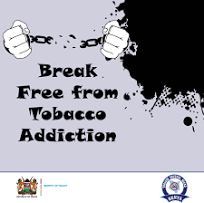The World Health Organization (WHO) has today launched a report highlighting how the tobacco and nicotine industry designs products and implements campaigns to get the world’s youth addicted.
In the report dubbed ‘Hooking the next generation’, WHO is amplifying the voices of young people who are calling on governments to protect them from being targets of the tobacco and nicotine industry.
This comes just ahead of the World No Tobacco Day (WNTD) that is normally marked annually on May 31. This year’s theme is focused on advocating for an end to the targeting of youth with harmful tobacco products.
Presented on a virtual meeting today ahead of the commemoration, the report shows that globally, an estimated 37 million children aged 13–15 years use tobacco, and in many countries, the rate of e-cigarette use among adolescents exceeds that of adults.
WHO Director-General Dr Tedros Adhanom Ghebreyesus says that industries were actively targeting schools, children and young people with new products that are essentially a candy-flavoured trap.
“History is repeating itself, as the tobacco industry tries to sell the same nicotine to our children in different packaging. How can they talk about harm reduction when they are marketing these dangerous, highly-addictive products to children?” Dr Tedros queried.
The Director General noted that despite significant progress in reducing tobacco use, the emergence of e-cigarettes and other new tobacco and nicotine products present a grave threat to youth and tobacco control.
Studies demonstrate that e-cigarette use increases conventional cigarette use, particularly among non-smoking youth, by nearly three times even as the industries continue to market their products to young people with enticing flavours like candy and fruit, he added.
In Kenya, the Kenya Tobacco Control Alliance (KETCA) Coordinator Thomas Lindi says that the use of e-cigarettes among teenagers between the ages of 13 and 15 is on the rise in the country.
“Companies manufacturing e-cigarettes are using packaging that attracts the teens into buying and using the product. These are highly addictive products, which include e-cigarettes and nicotine pouches which are popular among Kenyan schoolchildren and adolescents,” he noted.
Meanwhile, the lobby groups have declared their support for the ongoing review of Kenya’s Tobacco Control Act, 2007 and Regulation, 2014 considering that the prevalence of e-cigarettes consumption in Kenya is at 5.8 per cent.
Just last month, the Ministry of Health, through the Division of Drug and Substance Abuse Control and the Tobacco Control Board in collaboration with relevant stakeholders were in the process of reviewing the Tobacco Control Act 2007 and Tobacco Control Regulations 2014.
This initiative comes in response to the evolving landscape of tobacco products and the imperative to align legislative frameworks with the provisions of the Constitution of Kenya-2010.
The primary objective is to ensure the administrative and legislative viability of the existing laws and to effectively address the challenges posed by emerging novel nicotine and other emerging tobacco products, to safeguard public health and mitigate the detrimental effects of tobacco use on society.
WHO Director of Health Promotion Dr Ruediger Krech said that the use of child-friendly flavours like cotton candy and bubblegum, combined with sleek and colourful designs that resembled toys, was a blatant attempt to addict young people to these harmful products.
“These industries are intentionally designing products and utilizing marketing strategies that appeal directly to children and these deceptive tactics highlight the urgent need for strong regulations to protect young people from a lifetime of harmful dependence,” he added.
WHO is urging governments to protect young people from the uptake of tobacco, e-cigarettes and other nicotine products by banning or tightly regulating these products.
WHO recommends creating 100 percent smoke-free indoor public places, banning flavoured e-cigarettes, bans on marketing, advertising and promotion, higher taxes, increasing public awareness of the deceptive tactics used by the industry and supporting youth-led education and awareness initiatives.
Youth advocates around the world are also taking a stand against the tobacco and nicotine industry’s destructive influence and manipulative marketing by exposing these deceptive practices and advocating for their own tobacco-free future.
The Youth organizations from around the world participated in the latest session of the Conference of the Parties to the WHO Framework Convention on Tobacco Control (COP10) to deliver a powerful message to policy makers: “Future generations will remember you as the ones who protected them or the ones who failed them and put them in danger.”
According to WHO, by working together, governments, public health organizations, civil society, and empowered youth could create a world where the next generation is free from the dangers of tobacco and nicotine addiction.
According to Market insights consumer body in Kenya, the revenue generated by the e-cigarettes market is projected to reach Sh3.8 billion (USD29.0m) this year and taking into account the total population figures, per person revenue in Kenya is Sh90 (USD 0.68).
By Wangari Ndirangu




